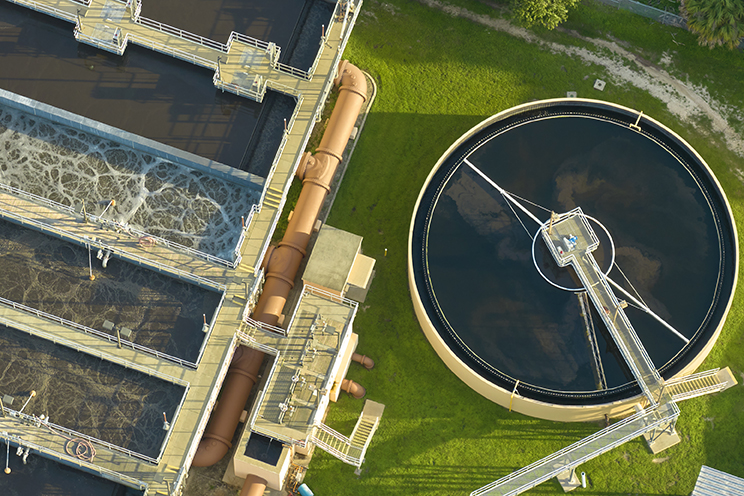Infrastructure is the foundation that connects the nation’s businesses, communities, and people. For the U.S. economy to be the most competitive in the world, we need a first-class infrastructure system – transport systems that move people and goods efficiently and at reasonable cost by land, water, and air; transmission systems that deliver reliable, low-cost power from a sustainable range of energy sources; and water systems that protect the public health. Yet today, our infrastructure systems are suffering from years of status quo levels of investment. Elected leaders on both sides of the political aisle need to make good on promises they have made to improve our nation’s infrastructure and ensure these pledges don’t fall by the wayside after each election cycle.
BRIDGING THE GAP
Economic Impacts of National Infrastructure Investment, 2024-2043
Assessing America’s Infrastructure Gap
$0 TRILLION
Surface Transportation
ANTICIPATED: $2.3T
TOTAL NEEDS: $3.5T
$0 BILLION
Energy
ANTICIPATED: $1.3T
TOTAL NEEDS: $1.9T
$0 TRILLION
Drinking Water – Wastewater – Stormwater
ANTICIPATED: $0.7T
TOTAL NEEDS: $1.7T
$0 BILLION
Water Transportation
ANTICIPATED: $32B
TOTAL NEEDS: $45B
$0 BILLION
Aviation
ANTICIPATED: $200B
TOTAL NEEDS: $300B
JUMP TO: Infrastructure Investment Gap | Failure to Act Economic Reports
*2020 dollar rate
The Breakdown of America’s Infrastructure Investment Gap
When we talk about a disparity between current infrastructure investment and what we need to improve and modernize our systems, it’s helpful to understand the real, live numbers. Here’s just a quick snapshot of how our infrastructure is falling behind in necessary funding:
Investment Gap Between Needs & Funding
Dams
$81 Billion
Levees
$70 Billion
Public Parks/ Recreation
$68 Billion
Inland Waterways/ Marine Ports
$25 Billion
Hazardous/ Solid Waste
$7 Billion
Surface Transportation
$1,125 Billion
Water/ Wastewater/ Stormwater
$434 Billion
Schools
$380 Billion
Electricity
$197 Billion
Airports
$111 Billion
The good news is that closing America’s infrastructure investment gap is possible with big, bold action from Congress, continued financial support from states and localities, and smart investments and management by infrastructure owners.
Failure to Act Economic Reports
Every four years, the American Society of Civil Engineers (ASCE) publishes the Report Card for America’s Infrastructure, which grades the current state of national infrastructure categories on a scale of A through F. Since 1998, America’s infrastructure has persistently earned low grades, and the failure to close the investment gap with needed maintenance and improvements has continued. But the larger question at stake is the implication of low infrastructure on America’s economic future.
The Failure to Act report series answers this key question—how does the nation’s failure to act to improve the condition of U.S. infrastructure systems affect the nation’s economic performance? In 2020 and 2021, ASCE released five Failure to Act reports in a series covering 11 infrastructure sectors that are critical to the economic prosperity of the U.S.
These reports were followed by a fifth, comprehensive final report, Failure to Act: Economic Impacts of Status Quo Investment Across Infrastructure Systems, which addressed the aggregate economic impact of failing to act in more than one sector. This report addresses the current infrastructure gaps between today’s needs and investment and how they will affect the future productivity of industries, national competitiveness, and the future costs to households.
Failure to Act: Economic Impacts of Status Quo Investment Across Infrastructure Systems
When we fail to invest in our infrastructure, we pay the price. Poor roads and airports mean travel times increase. An aging electric grid and inadequate water distribution make utilities unreliable. Problems like these translate into higher costs for businesses to manufacture and distribute goods and provide services. These higher costs, in turn, get passed along to workers and families.
Over the next 20 years, America’s overdue infrastructure bill will cost the average American household $3,300 a year.
The average American household loses $63 a week due to chronic underinvestment in infrastructure. What could you buy with $63 a week, or $275 a month?

TAKEOUT DINNER FOR A FAMILY OF FOUR EACH WEEK.

STARTING A COLLEGE FUND.

DOING A HOME RENOVATION PROJECT.
Inefficient, unreliable infrastructure is a drag on the U.S. economy and will hurt the GDP and create job losses. 47% of the projected jobs lost in 2039 will be in high wage and high production jobs like manufacturing and healthcare.
We are already paying the price, but if we fail to act now, our costs will mount exponentially. Of the total economic impacts projected in our 20-year study, more than three-quarters occur during the second decade (2030-2039). If we don’t act, by 2039 we are forecasted to lose:
$0 TRILLION
in GDP from 2020-2039, nearly half of the annual U.S. GDP in 2019.
$0 TRILLION
in exports from 2020-2039, or more than all of the Fortune 500 companies generated in profits in 2019.
0 MILLION
jobs, two times the number of Walmart employees in the U.S.
The good news is we can ACT NOW to mitigate the harm to our GDP, trade volumes, and declines in personal income. Let’s reverse the decade of underinvestment in our infrastructure and help all communities thrive.
This study was conducted in 2020. The Infrastructure Investment and Jobs Act became law in November 2021, reversing federal underinvestment trends. The full impacts of the law aren’t yet known. However, it’s already clear that while the $1.2 trillion bipartisan infrastructure law is enormously helpful, it doesn’t fully close our investment gap. This means American families and businesses are still paying the price for underperforming infrastructure.
Recent Failure to Act Economic Reports Include:
Ports and Inland Waterways (2021)
Underinvestment in ports and inland waterways stand to increase waterborne shipping costs from 8% to 22%, on average, by 2039. Manufacturing, agriculture, and production and extraction are most impacted.
Airports (2021)
A recent uptick in airport infrastructure investment is paying dividends for the residents and businesses in the U.S. However, as spending returns to previous averages, the economy will suffer. Specifically, airport congestion will cost U.S. industries and households approximately $28 billion in 2029 and $41 billion in 2039.
Electricity (2020)
An additional investment of $16.9 billion per year between now and 2039 in our electricity infrastructure can protect 540,000 jobs and $5,800 per household in personal income.
Water and Wastewater (2020)
By investing in our water infrastructure to make it more reliable, we can prevent $250 billion in increased costs to businesses by 2039.
Surface Transportation (2021)
These findings show that if industry costs are passed onto customers, costs per household could be as high as $12,500 over 20 years, or $625 dollars per year. Losses to households and industries will amount to $677 billion over the 2020–2029 period and $1.3 trillion during the 2030–2039 decade.






